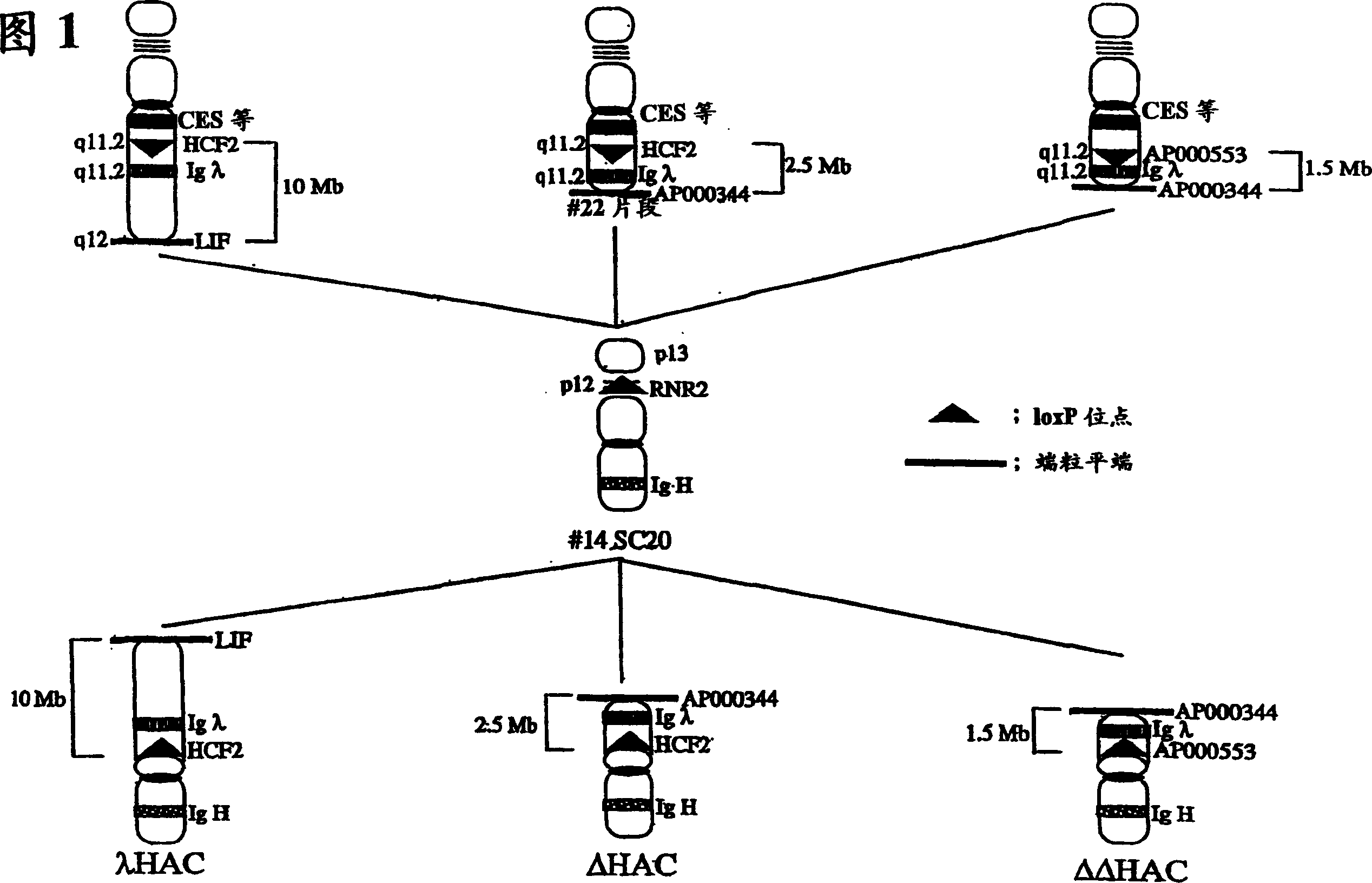Human artificial chromosome containing human antibody lambda light chain
A light chain gene and human antibody technology, applied in genetic engineering, antibodies, anti-animal/human immunoglobulin, etc., can solve the problem of low chimerism in chimeric mice
- Summary
- Abstract
- Description
- Claims
- Application Information
AI Technical Summary
Problems solved by technology
Method used
Image
Examples
Embodiment 1
[0077] [Example 1] Production of expression cassette vector pTELhisD
[0078] The expression cassette vector pTELPuro (Kuroiwa et al., Nature Biotech., 18: 1086-, 2000) was cut with restriction enzyme NotI (Boehringer), and blunted at 72°C for 5 minutes using a DNA blunting kit (Toyobo Co., Ltd.). After blunting, it was dephosphorylated at 65° C. for 1 hour using bacterial-derived alkaline phosphatase (Takara Shuzo Co., Ltd.). Thereafter, a restriction enzyme BglII linker (Takara Shuzo Co., Ltd.) was added, and ligation was performed using a ligation kit (Takara Shuzo Co., Ltd.). The plasmid pTELBg in which the BgIII linker replaces the PGKPuro expression cassette in the pTELPuro plasmid was thus generated. This plasmid was cut with restriction enzyme BglII, and dephosphorylated in the same manner. Thereafter, it was purified by gel filtration using CHROMA SPIN-TE 400 (Clontech). Subsequently, the hisD fragment was excised from plasmid #1-132 (provided by Professor Shun-ich...
Embodiment 2
[0079] [Example 2] Production of targeting vector pTELhisDλI
[0080] The targeting vector pTELhisDλI for inserting the human telomere sequence into the AP000344 region very close to the Igλ locus on human chromosome 22 and on the telomere side (approximately 400 Kb telomere side) was produced in the following manner. Initially, the AP000344 genomic region was amplified by PCR using the following primers.
[0081] 1269D1-F; 5'-TCGAGGATCCGACAAGTTCTCTTCTCTTTTCCTTCTGCCC-3' (SEQ ID NO: 1)
[0082] 1269D1-R; 5'-TCGAGGATCCGCTGCTAAGCTACTGTTCTCTTTTTTCCCC-3' (SEQ ID NO: 2)
[0083] PCR was performed using GeneAmp 9600 (manufactured by Perkin-Elmer) as a thermal cycler, LA Taq (Takara Shuzo Co., Ltd.) as Taq polymerase, and ligation buffer and dNTP (dATP, dCTP, dGTP, dTTP). For temperature and cycle conditions, after heat denaturation at 94°C for 1 minute, 35 cycles were performed at 98°C for 10 seconds and 68°C for 11 minutes. The PCR product was treated with proteinase K (Gibco), ...
Embodiment 3
[0084] [Example 3] Production of targeting vector p5531oxPHyg
[0085] The targeting vector p553loxPHyg, which is used to insert the Cre recombinase recognition sequence loxP sequence into AP000553 very close to the Igλ locus on human chromosome 22 and on the centromere side (about 300Kb centromere side), was produced in the following manner Area. Initially, the AP000553 genomic region was amplified by PCR using the following primers.
[0086] 553-F3; 5'-TCGAGTCGACTGTAGCTGACTTTAGCCACCCACAAGTAC-3' (SEQ ID NO: 3)
[0087] 553-R3; 5'-TCGAGTCGACCTTGCTGATTATACCTCATCCTCCTTCCCTC-3' (SEQ ID NO: 4)
[0088] PCR was performed using GeneAmp 9600 (manufactured by Perkin-Elmer) as a thermal cycler, LA Taq (Takara Shuzo Co., Ltd.) as Taq polymerase, and ligation buffer and dNTP (dATP, dCTP, dGTP, dTTP). For temperature and cycle conditions, after heat denaturation at 94°C for 1 minute, 35 cycles were performed at 98°C for 10 seconds and 68°C for 15 minutes. The PCR product was treated ...
PUM
 Login to View More
Login to View More Abstract
Description
Claims
Application Information
 Login to View More
Login to View More - R&D
- Intellectual Property
- Life Sciences
- Materials
- Tech Scout
- Unparalleled Data Quality
- Higher Quality Content
- 60% Fewer Hallucinations
Browse by: Latest US Patents, China's latest patents, Technical Efficacy Thesaurus, Application Domain, Technology Topic, Popular Technical Reports.
© 2025 PatSnap. All rights reserved.Legal|Privacy policy|Modern Slavery Act Transparency Statement|Sitemap|About US| Contact US: help@patsnap.com



